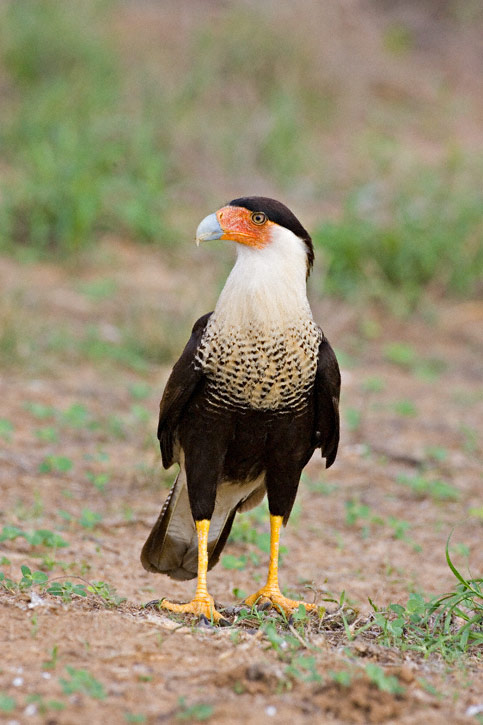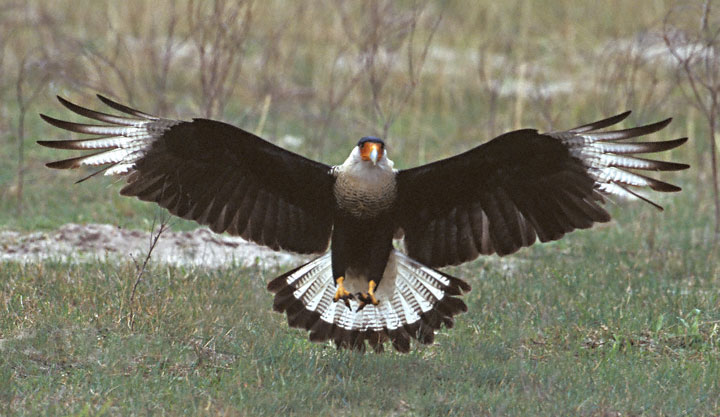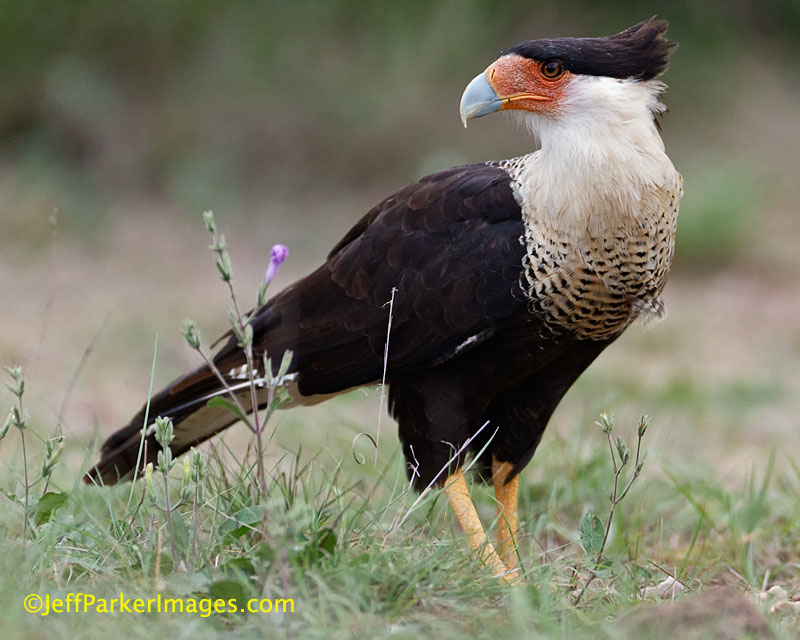
Polyborus plancus
SUBFAMILY
Polyborinae
TAXONOMY
Polyborus plancas J. F. Miller, 1777, Tierra del Fuego. About
three or four extant subspecies.
OTHER COMMON NAMES
English: Common caracara, Guadeloupe caracara; French:
Caracara huppй; German: Schopfkarakara; Spanish: Caracara
Carancho.
PHYSICAL CHARACTERISTICS
19–23 in (49–59 cm); in Panama male 1.8 lb (835 g), female
2.1 lb (955 g); larger in Chile and Peru 2.5–3.5 lb (1,150–1,600
g). A distinctive heavy-beaked falconid with a laterally flattened
head, black cap with slight crest, and a bare red face; longlegged
and somewhat terrestrial. Mantle, rump, throat, and
vent are white or buff and finely marked with black; rest of
back is brown-black and finely marked with white or buff;
breast is brown-black; tail is barred black and buff with black
wide-barred tip. Juvenile is browner and more streaked. Races
differ somewhat in size and color.
DISTRIBUTION
Central and South America from the southern United States
(Texas to Arizona, and Florida) to Tierra del Fuego and the
Falkland Islands.
HABITAT
Typically lowland open and semiopen country: grazing land,
pasture, river edge. Also Patagonian river valleys, shrub steppe,
and grassy foothills. Increasingly moving into uplands of
Colombia and Ecuador.
BEHAVIOR
Gregarious, gather at carcasses. Outside the breeding season
they roost communally in the tops of isolated trees. Quite vocal,
with a loud raucous territorial call made in characteristic
pose with head thrown far back. Some local movements, but
largely sedentary.
FEEDING ECOLOGY AND DIET
Among the most opportunistic of raptors. Walks over ground
and through shallow water in search of prey; arrives at carcasses
before vultures. Typically feeds on carrion, road kills,
and dead and dying fish and livestock. Occasional live prey includes
turtles, iguanas, snakes, crabs, earthworms, caterpillars,
and beetles. Raids nests of passerines and other caracaras, and
egret and spoonbill colonies. Aggressive; steals prey from other
caracaras and raptors; pursues pelicans until the pelicans regurgitate.
Eats coconut flesh at harvest in Guyanan plantations.
REPRODUCTIVE BIOLOGY
Breeds as solitary pair over a prolonged season; occasionally
two clutches in same year. Builds a large rough lined or unlined
nest of sticks on top of cactus or palms, on dense tangles
of tree branches, or on the ground. The usual clutch is two
eggs; incubation is about a month. Fledglings remain with
adults for perhaps three months.
CONSERVATION STATUS
Not threatened. Generally common and locally abundant.
Some local persecution and population decreases where they
are poisoned and shot for predation on lambs. habitat loss of
farmland to citrus plantation threatens Florida population, but
elsewhere conversion of forest to ranch land has helped species
expand its
DISTRIBUTION
.
SIGNIFICANCE TO HUMANS
The caracara is the national bird of Mexico, a nod to Aztec
legend.
Other popular Animals
Photo Gallery of - Crested caracara




 Animalia Life
Animalia Life